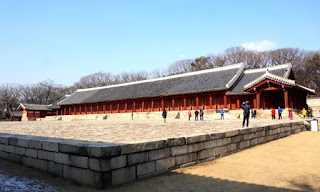Korea's Tour Attractions...Jongmyo Shrine
Jongmyo Shrine, located in Jongno-gu, Seoul is the royal shrine interred with the ancestral tablets of Joseon Dynasty’s royal family and the place where memorial services for the kings and queens are performed. It was listed as UNESCO World Heritage in 1995.
The place itself has the greatest religious implications from a Confucian perspective and it is a sacred site that presented the legitimacy of the political principal of the time. It is also a great representation of the culture and legacy of the royal family.
First built around the end of 14th century by King Taejo, the founder of the Joseon Dynasty, the current Jongmyo Shrine was a reconstructed in the 17th century after the Imjin War (1592-1598).
The main building is Jeongjeon Hall, an impressive 150 meters long by 100 meters wide wooden structure that stands in good harmony with the courtyard and auxiliary buildings. The unique atmosphere is considered to be a one-of-a-kind historical monument, found nowhere else in Asia, let alone Western nations.
Following the Confucian culture of honoring one’s ancestors, a ceremony known as Jongmyo Jerye is held for the royal family of the Joseon Period within the site. The buildings along with intangible heritages of rituals, music, dancing and food are all protected at Jongmyo Shrine, making it a veritable cultural asset.
Whole Scene of Jongmyo
Major Heritage Sites
Hamabi Monument
Before the main entrance of Jongmyo Shrine is the Hamabi, a commandment stone indicating that anyone who passes by should get off his horse as a form of respect to the ancestors. Even the kings and queens were required to get down from their palanquins in order to pay their respects to the former rulers.
Jeongjeon Hall
Jeongjeon Hall is the largest wooden structure in Korea. The front facade features 20 pillars with doors in the space between. While the outside of the structure is rather plain, the interior is elaboratly decorated for the pleasure of the ancestors' spirits. Visitors cannot enter Jeongjeon Hall, but can get an idea by viewing a replica in Exhibition Hall 2 of Hyangdaecheong.
There are three main gates to Jeongjeon on the east, west and south sides. The path located to the south is reserved for the royal spirits and thus no living soul is allowed to step foot on it. The two other gates are for mortals: the east gate was for the king and crown prince while the west gate was for musicians and dancers performing at the memorial ceremony.
Yeongnyeongjeon Hall
The area of Jeongjeon Hall was too small to hold all of the ancestral tablets, so Yeongnyeongjeon Hall, meaning ‘Hall of Eternal Comfort’, was built as an annex building. Compared with the main hall, Yeongnyeongjeon Hall is smaller and holds fewer tablets. One distinctive feature is that the annex has section of a taller roof at the center, while Jeongjeon Hall has an uninterrupted roofline. Yeongnyeongjeon Hall holds the tablets of kings and queens whose reign was either rather short or who were recorded with no notable achievements.
Jongmyo Ceremony





No comments:
Post a Comment